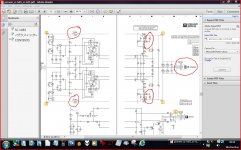Hello.
I have a problem with my SC-LX71. the B REG ASSY fuse keeps blowing
Does anyone know where the fault is? I replaced B REG ASSY with a new one, but it did not matter.
pleace help
I have a problem with my SC-LX71. the B REG ASSY fuse keeps blowing
An externally hosted image should be here but it was not working when we last tested it.
Does anyone know where the fault is? I replaced B REG ASSY with a new one, but it did not matter.
pleace help
Unfortunately no. The fuse blows immediately. I have tried to measure many places without success. After what I have been able to find is that the B REC ASSY blocks all the power if match the volts not quite correct 100%. as a protect ASSY
Its a hugely complex unit. Is it FU61 or FU62 that is blowing. If so then you need to check for shorts on the -/+64 rails that this regulator supplies.
Hi,
Check with an ohmmeter the resistance between the load side of the blown fuse and ground. Low resistance reading means you have a short.
Check with an ohmmeter the resistance between the load side of the blown fuse and ground. Low resistance reading means you have a short.
I also thought about it, so I ordered two new. I could not measure some errors in them sitting in. But now I will try to change them🙂
On the diagram I looked at the fuses on the B Reg Assy feed the input to two discrete 64 volt (-/+) series pass regulators. Your problem is almost certainly something drawing excess current from these regulators.
Its a fearsome manual, some 200 pages in size.
Its a fearsome manual, some 200 pages in size.
Yes it is a very huge book! 🙂
I very much hope that it's Regulators that has the problem. Everything is made more and more with SMD which is not easy to work with.
I hope you're right! 🙂
sorry my English since I live in Denmark 🙂
I very much hope that it's Regulators that has the problem. Everything is made more and more with SMD which is not easy to work with.
I hope you're right! 🙂
sorry my English since I live in Denmark 🙂
You need to look at what those regulators feed which will be other boards and other parts of the circuitry. I think you will find that that is where the problems are. Not the regulators themselves but the circuits they feed.
I've tried to disconnect all cables that lead from B REG ASSY and beyond. In this way, it was only B REG ASSY got power. Yet both fuses destroyed.
I will just say that B REG ASSY supplies motherboard, but why are the fuses still blowing when the motherboard disconnected
I will just say that B REG ASSY supplies motherboard, but why are the fuses still blowing when the motherboard disconnected
I can not measure any short circuit on the cable down to the motherboard, but it is not always to be sure
I haven't got the manual in front of me (its on another PC) but I'm pretty sure there isn't anything low impedance on that board that would have blown fuses. You need to check everything that connects to the emitters of the two series pass transistors.
The only thing these two regulators supplies the B REG ASSY. do you think the problem is on the B DIODE ASSY or after
Talk with a good ohmmeter the actual opposition relating to the insert part in the broken blend and floor. Small opposition reading means you have a limited.
An externally hosted image should be here but it was not working when we last tested it.
My big problem is that I'm not sure which part of the amplifier I have to find the error. I spent many hours with my ohmmeter but it has not shown any conclusive.
It all started after a fun evening with loud music, the next morning it would not turn on.
It all started after a fun evening with loud music, the next morning it would not turn on.
If these are the fuses that are blowing then you need to trace and isolate whatever the output (at the right) feeds. Does it go to the ICE power modules ? Something like that would be favourite as a failure item, particularly as you said it failed after a night of loud music. The two 'zeners' marked will fail short circuit if there is an overvolts condition.
You are going to have to trace out where the -/+64 volts goes and then isolate sections at a time.
You are going to have to trace out where the -/+64 volts goes and then isolate sections at a time.
Attachments
- Status
- Not open for further replies.
- Home
- Amplifiers
- Solid State
- Pioneer sc-lx71 blowing fuses

